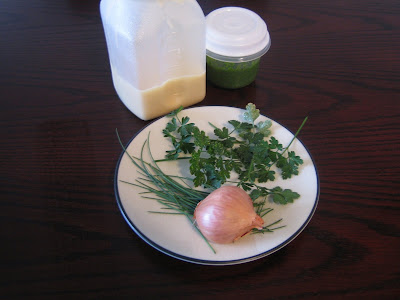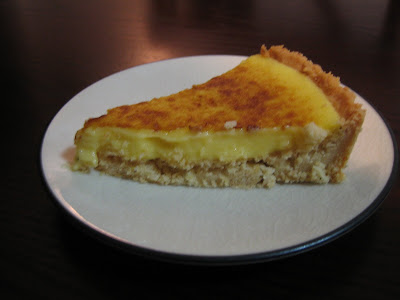By no means have I made a large percentage of the Bouchon recipes yet, but patterns are certainly emerging. One of them is the use of vinaigrette with vegetables. Another is the pairing of hard-boiled eggs and vegetables. Another is the use of a lot of fresh herbs. Just check out the asparagus post if you don't believe me. All of these were in play for this salad.
The ingredients list for this salad is pretty long, especially for something in which he description starts off with 'This is a pretty straightforward salad..." Here's the full list: haricots verts, red onion, fennel, salt and pepper, Pernod, olive oil, tomatoes, eggs, olives, anchovy, basil puree, vinaigrette, shallots, chives, tarragon, chervil, and parsley. I cut a few corners and ended up with what you see below:
 That would be fennel, hard-boiled eggs, heirloom tomatoes, red onion, and green beans for the 'meat' of the salad. Add to that the vinaigrette, basil puree, shallots, parsley, and chives for the dressing.
That would be fennel, hard-boiled eggs, heirloom tomatoes, red onion, and green beans for the 'meat' of the salad. Add to that the vinaigrette, basil puree, shallots, parsley, and chives for the dressing. That means that I left out five ingredients. Try and figure it out? Get it? No? You didn't try? Fine. I left out the Pernod (hate the taste), olives (hate the taste), anchovy (totally forgot them at the store), tarragon and chervil (too cheap). Now that we have that all ironed out, let's do a little cooking and a bunch of assembling.
That means that I left out five ingredients. Try and figure it out? Get it? No? You didn't try? Fine. I left out the Pernod (hate the taste), olives (hate the taste), anchovy (totally forgot them at the store), tarragon and chervil (too cheap). Now that we have that all ironed out, let's do a little cooking and a bunch of assembling.The first step was to blanch the green beans. I boiled a large pot of water and dumped a bunch of salt into it, because "it should taste like the sea" according to Sir Keller. In went the green beans for about four or five minutes, after which I drained them and transferred them to an ice bath. After another draining I laid them out onto paper towels to dry them further. Finally convinced that they were dry, I put them into the fridge to chill for awhile.
Next up was the chopping of the red onion into thin slices. I made sure that all of the pieces were cleanly separated and put those into the refrigerator as well. The fennel required a tad bit more careful dissection, and I wish I had taken some pictures of it because it was the first time I'd ever cooked with fennel. Gotta save the memories forever! I almost left it out for the same reasons I left out the Pernod, but it really wasn't too strong of a flavor in the final dish so I'm glad I didn't. Anyway, I cut the bulb of the fennel in half and removed what was obviously an inedible core and then sliced it into slices just like the onion. I tossed the fennel with some salt and olive oil (this is where the Pernod would of come in) and that joined the beans and the onion in the fridge.
Last up for a trip to the refrigerator were the tomatoes. I purchased two nice looking heirloom tomatoes, one red and one yellow, and sliced them fairly thinly. They got sprinkled with some salt and pepper and drizzled with olive oil. Guess what's next? That's right, into the fridge they went.
Ok, now it's time to end this lack of pictures and start assembling the salad. The bottom layer of the salad was the tomatoes. They're not the prettiest slices you've ever seen, but I promise you that they taste exactly the same as even the most perfect slices you've ever laid your eyes on. I seasoned them with a bit more salt and pepper.

Meanwhile, I tossed all of the dressing ingredients that I was using with the beans until they were well coated and then mixed that with the onion and fennel. All of that got mounded on top of the tomatoes. I'm using mounded loosely here, since it pretty much just collapsed into a single layer.

The final garnish was to add hard-boiled egg quarters. This is where the anchovy and olives would have come in as well, but I skipped that part.

And there you have it. It was very good and highlighted the concepts that Bouchon does best. That is, it lets the fresh vegetables speak for themselves but still adds additional flavor through the dressing and extra texture with the eggs. All that being said, you could take this salad down just a notch and have something that would be 95% as good and take 30% of the time. I would consider trading the basil puree for a little fresh basil next time, and also probably leave out the fennel. Those two changes alone would make the dish extraordinarily easy, quick, cheap, and still extremely good. I'm learning quickly that it's really kind of hard to mess up fresh, in season vegetables. This one is a keeper.













































